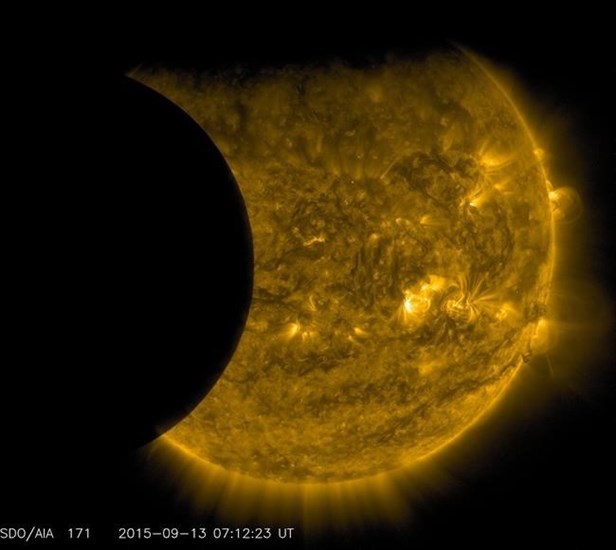
This Sept. 13, 2015 image provided by NASA shows the moon, left, and the Earth, top, transiting the sun together, seen from the Solar Dynamics Observatory. The edge of Earth appears fuzzy because the atmosphere blocks different amounts of light at different altitudes. This image was taken in extreme ultraviolet wavelengths, invisible to human eyes, but here colorized in gold. A total lunar eclipse will share the stage with a so-called supermoon Sunday evening, Sept. 27, 2015 as seen from the United States. That combination hasn't been seen since 1982 and won't happen again until 2033.
Image Credit: NASA/SDO via AP
September 26, 2015 - 4:30 PM
Stargazers across Canada are preparing for a rare and spectacular celestial light show this Sunday night.
If the sky remains clear, those who look aloft will witness a total lunar eclipse as the Earth casts its shadow across a so-called supermoon, starting shortly after 6 p.m., Sept. 27.
The term supermoon refers to the fact that Earth's pale neighbour will be at its closest point to our planet, known as perigee.
The simultaneous nature of these lunar events has attracted a great deal of attention, but some astronomers and physicists say the supermoon phenomenon is overblown.
"The moon is still far enough away that it's really not a big difference," says Catherine Lovekin, assistant physics professor at Mount Allison University in Sackville, N.B.
"It will be a little bit brighter ... and a little bit bigger. But it's really not much of a difference at all. Just by looking, you won't be able to tell."
According to NASA, as the full moon makes its closest approach to the Earth at 356,900 kilometres, it will appear only 14 per cent larger than usual.
David Lane, observatory director at St. Mary's University in Halifax, says he, too, is not a fan of the supermoon moniker.
"We're happy that it provides lots of public awareness of astronomy, but as far as it being super — it's not."
Still, a total eclipse can be fascinating to watch as the moon transforms into a reddish colour over a three-hour period, an eerie wonder known as a Blood Moon.
"It's a particularly spectacular event on its own," says Lovekin, who plans to be on hand to answer questions Sunday when the university opens its two-telescope observatory to the public, weather permitting.
The ghostly red hue associated with most total eclipses — some have a copper shade — is caused by the same process that gives us memorable sunrises and sunsets, says Lane.
"Some of the light bends or refracts around the atmosphere and hits the moon, allowing us to see it on the Earth," he says. "The red light just keeps on going and the blue light gets scattered around in the atmosphere and causes the sky to be blue."
The Blood Moon has inspired legends, folklore and predictions of doom for thousands of years, but Lovekin says a plethora of scientific studies have debunked the myth that the appearance of a full moon alters human behaviour.
"People don't act crazier during a full moon," she says.
Barring cloudy weather, there is no special gear needed to view a supermoon eclipse, though some observers use binoculars to get a closer look at the undulating shadows on the moon's craggy surface.
The timing for Sunday's show will be good for most parts of Canada, but those on the West Coast will miss the initial stages of the eclipse because the moon will be low in the sky as the sun sets.
Even though there have been three total eclipses in the past 18 months, Lovekin says it would be a mistake to think these are common events. Owing to the slight tilt of the moon's egg-shaped orbit around the Earth, eclipses come in bunches of four.
That's why the next total eclipse won't happen until 2018.
As for the much-hyped combination with the supermoon, that is an exceptionally rare event, occurring only five times since 1900 — 1910, 1928, 1946, 1964 and 1982.
The next total eclipse of a supermoon won't happen until 2033.
NASA will provide a live video feed of the entire eclipse — an option in case clouds obscure your own view.
News from © The Canadian Press , 2015